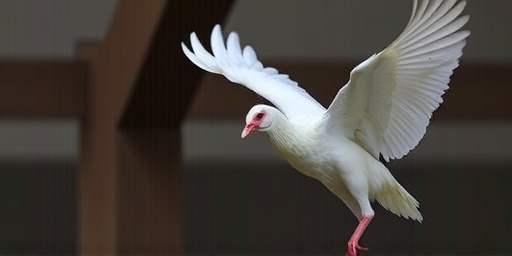SEATTLE, Washington – In a alarming development for public health, a 52-year-old man from King County near Seattle has become the first known human victim of the H5N5 bird flu strain, succumbing to severe complications after hospitalization. Health officials confirmed the human infection on Thursday, marking a potential zoonotic spillover that has ignited fears of wider transmission in the U.S.
- King County Man’s Poultry Exposure Linked to Deadly H5N5 Infection
- H5N5 Bird Flu Emerges in Washington Wild Birds and Farms
- Public Health Officials Launch Contact Tracing Amid Low Transmission Risk
- Experts Highlight Zoonotic Parallels to Past Bird Flu Crises
- Future Surveillance and Vaccine Efforts Target H5N5 Spread
The Washington State Department of Health (DOH) reported that the man, identified only as a resident of unincorporated King County, sought medical attention on October 15 after experiencing flu-like symptoms including fever, cough, and shortness of breath. His condition deteriorated rapidly, leading to respiratory failure and death on October 22. Tests conducted by the CDC verified the presence of the H5N5 avian influenza virus, a subtype previously detected only in wild birds and poultry abroad.
“This is the first documented H5N5 case in a human in the United States, and we’re treating it with the utmost urgency,” said Dr. Umair Shah, Secretary of the Washington State Department of Health, in a press briefing. “While the risk to the general public remains low, we’re mobilizing resources to trace contacts and monitor for any secondary spread.”
King County Man’s Poultry Exposure Linked to Deadly H5N5 Infection
The deceased man worked part-time at a local poultry processing facility in Auburn, Washington, where he handled live birds imported from Asia. State veterinarians had flagged low-level H5N5 detections in U.S. wild ducks earlier this year, but no outbreaks were reported in commercial flocks until last month. Investigators believe the man was exposed while culling infected birds without adequate protective gear.
According to preliminary epidemiological data, the man’s symptoms began four days after his last shift. He initially dismissed them as seasonal flu but was admitted to Harborview Medical Center when pneumonia set in. Antiviral treatments like oseltamivir (Tamiflu) were administered, but the virus’s aggressive nature overwhelmed his immune system.
- Timeline of Events:
- October 11: Last exposure at poultry facility
- October 15: Hospitalized with fever (103°F) and respiratory distress
- October 18: Placed on ventilator; samples sent to CDC
- October 22: Death from multi-organ failure
- October 24: H5N5 confirmed
Family members reported no unusual bird contact at home, though the man kept backyard chickens. The property has been quarantined, and over 200 birds culled as a precaution. “He was a hardworking family man who loved his birds,” said neighbor Maria Gonzalez. “None of us saw this coming.”
H5N5 Bird Flu Emerges in Washington Wild Birds and Farms
The H5N5 subtype, part of the highly pathogenic avian influenza (HPAI) family, has circulated in Europe and Asia since 2021, infecting wild waterfowl and domestic poultry. In Washington, the virus was first isolated from a mallard duck in Skagit County in March 2024, prompting USDA surveillance. By September, low-pathogenic strains appeared in commercial turkey farms in Yakima Valley, but the human case elevates concerns.
Washington’s robust poultry industry, valued at $1.2 billion annually, processes millions of birds yearly. The state leads U.S. turkey production, making it a hotspot for bird flu monitoring. “We’ve enhanced biosecurity measures since H5N1 outbreaks in 2022-2023, which killed 58 million birds nationwide,” noted Dr. Julie Gauthier, state veterinarian. “But H5N5’s jump to humans underscores the need for vigilance.”
Genomic sequencing by the CDC reveals the victim’s strain closely matches European H5N5 isolates, suggesting migratory bird pathways via the Pacific Flyway. Experts warn that climate-driven bird migrations could accelerate spread.
| Avian Flu Strains in U.S. (Recent Years) | Cases in Birds | Human Cases |
|---|---|---|
| H5N1 | 1,000+ outbreaks | 2 mild (2024) |
| H5N5 | 15 detections (2024) | 1 fatal (first) |
| H7N9 | Rare | 0 (U.S.) |
Public Health Officials Launch Contact Tracing Amid Low Transmission Risk
In response to the Washington human infection, public health teams have identified 47 close contacts, including 22 coworkers and 15 family members. All are under quarantine and receiving prophylactic antivirals. As of Friday, none show symptoms, but twice-daily monitoring continues for 10 days.
The CDC has classified the risk as “low” for the general population, citing no evidence of sustained human-to-human transmission. However, healthcare workers at Harborview are screened weekly. “H5N5 binds efficiently to avian receptors but poorly to human ones,” explained Dr. Richard Webby, a virologist at St. Jude Children’s Research Hospital. “That said, mutations could change that, as seen with H5N1 dairy worker cases earlier this year.”
- Immediate Actions: Quarantine of exposed individuals
- Surveillance Boost: Enhanced wastewater testing in Seattle metro
- Vaccine Prep: Candidate vaccines in development
Washington Governor Jay Inslee activated emergency protocols, allocating $5 million for avian flu response. “We’re ahead of this, but preparedness saves lives,” Inslee stated.
Experts Highlight Zoonotic Parallels to Past Bird Flu Crises
This H5N5 bird flu fatality echoes historical zoonotic events. China’s 2014-2017 H7N9 outbreak sickened 1,600+ humans, killing 600, mostly via wet markets. In the U.S., H5N1 infected two dairy workers in 2024 with mild conjunctivitis, but no deaths. H5N5’s novelty raises alarms: a 2023 study in Emerging Infectious Diseases noted its high mortality in ferrets, a human disease model.
Dr. Marion Koopmans, a WHO avian flu specialist, commented: “The Washington case is a wake-up call. Poultry workers worldwide face highest risk; PPE compliance is critical.” Global surveillance via the World Organisation for Animal Health (WOAH) tracks H5N5 in 12 countries, with 300 million birds culled since 2021.
In Washington, backyard flocks pose unique challenges. A 2024 DOH survey found 15% of residents own birds, often without biosecurity. Educational campaigns urge cooking poultry thoroughly (165°F internal) and avoiding raw milk.
Future Surveillance and Vaccine Efforts Target H5N5 Spread
Looking ahead, the CDC plans nationwide H5N5 testing expansion, prioritizing Pacific Northwest states. mRNA vaccine platforms, successful against H5N1, are adapting to H5N5 antigens. “We could have doses ready in months if needed,” said NIH Director Dr. Monica Bertagnolli.
Public health messaging emphasizes hygiene: handwashing, avoiding sick birds, and reporting dead wildlife. Washington’s Fish and Wildlife Department urges hunters to report anomalies via a hotline (1-877-933-9847).
Economically, poultry prices may rise 5-10% if quarantines expand, per USDA forecasts. Internationally, the WHO monitors for reassortment risks with seasonal flu. “This single case doesn’t herald a pandemic, but it demands action,” Shah reiterated. Residents are advised to stay informed via DOH updates, as investigations continue into potential silent spread.
As fall migration peaks, experts predict more detections. Proactive measures now could prevent tomorrow’s crisis, safeguarding public health from evolving threats like H5N5.









